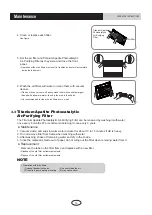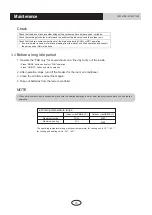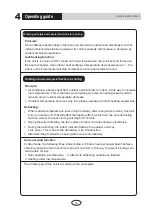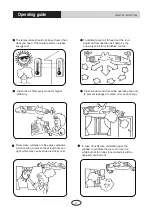
Connecting the refrigerant pipe
Wrench
Indoor unit tubing
Open-end wrench (fixed)
Connection pipe
Flare nut
1) Use torque wrenches when tightening the flare nuts to prevent damage to the flare nuts and gas leaks.
Coat here with refrigeration oil
2) Align the centres of both flares and tighten the flares and tighten the flare nuts 3 or 4 turns by hand.
Then tighten them fully with the torque wrenches.
3) To prevent gas leakage, apply refrigeration oil on both inner and outer surfaces in the flare. (Use refrigeration oil for
R410A.)
Liquid side
09K/12K
18K
09K/12K/18K
3/8 inch
1/2 inch
1/4 inch
31-35 N.m
50-55 N.m
15-20 N.m
Flare nut tightening torque
Gas side
Gas side
Gas
pipe thermal insulation
Caution on piping handling
1)Protect the open end of the pipe against dust and moisture.
2)All pipe bends should be as gentle as possible. Use a pipe bender for
bending.
(Bending radius should be 30 to 40mm or larger.)
Gas pipe
Gas pipe
insulstion
Finising tape
Inter-unit wiring
Liquid pipe
Liquid pipe
insulation
Selection of copper and heat insulation materials
When using commercial copper pipes and fittings, observe the
following:
1)Insulation material: Polyethylene foam
Heat transfer rate:0.041 to 0.052W/mK(0.035 to 0.045kca/(mh
Refrigerant gas pipe’s surface temperature reaches 110 max.
Choose heat insulation materials that will withstand this temperature.
2)Be sure to insulate both the gas and liquid piping and to provide insulation dimensions as below.
Liquid side
Liquid pipe
thermal insulation
18K
18K
09K/12K
09K/12K
Thickness 0.8mm
Thickness 10mm Min.
O.D. 9.5mm
O.D. 12.7mm
O.D. 6.4mm
I.D. 12-15mm
I.D. 14-16mm
I.D. 8-10mm
3)Use separate thermal insulation pipes for gas and liquid refrigerant pipes.
Be sure to
place a cap.
If no flare cap is
available,cover
the flare mouth
with tape to keep
dirt or water out.
INSTALLATION INSTRUCTIONS
Installation of indoor unit
2
5










































